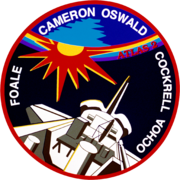STS-56
 Components of the ATLAS-2 laboratory in the payload bay of Discovery | |
| Names | Space Transportation System-56 |
|---|---|
| Mission type | Scientific research |
| Operator | NASA |
| COSPAR ID | 1993-023A |
| SATCAT no. | 22621 |
| Mission duration | 9 days, 6 hours, 8 minutes, 19 seconds |
| Distance travelled | 6,202,407 km (3,853,997 mi) |
| Orbits completed | 148 |
| Spacecraft properties | |
| Spacecraft | Space Shuttle Discovery |
| Landing mass | 93,683 kg (206,536 lb) |
| Payload mass | 7,026 kg (15,490 lb) |
| Crew | |
| Crew size | 5 |
| Members | |
| Start of mission | |
| Launch date | April 8, 1993, 05:29:00 UTC (1:29 am EDT) |
| Launch site | Kennedy, LC-39B |
| Contractor | Rockwell International |
| End of mission | |
| Landing date | April 17, 1993, 11:37:19 UTC (7:37:19 am EDT) |
| Landing site | Kennedy, SLF Runway 33 |
| Orbital parameters | |
| Reference system | Geocentric orbit |
| Regime | Low Earth orbit |
| Periapsis altitude | 291 km (181 mi) |
| Apoapsis altitude | 299 km (186 mi) |
| Inclination | 57.00° |
| Period | 90.40 minutes |
| Instruments | |
| |
 STS-56 mission patch  Standing: Cockrell, Foale, Ochoa Seated: Oswald, Cameron | |
STS-56 was a NASA Space Shuttle Discovery mission to perform special experiments. It was Discovery's 16th flight. The mission was launched from Kennedy Space Center, Florida, on April 8, 1993.
Crew
[edit]| Position | Astronaut | |
|---|---|---|
| Commander | Second spaceflight | |
| Pilot | Second spaceflight | |
| Mission Specialist 1 | Second spaceflight | |
| Mission Specialist 2 Flight Engineer |
First spaceflight | |
| Mission Specialist 3 | First spaceflight | |
Crew seat assignments
[edit]| Seat[1] | Launch | Landing |  Seats 1–4 are on the flight deck. Seats 5–7 are on the mid-deck. |
|---|---|---|---|
| 1 | Cameron | ||
| 2 | Oswald | ||
| 3 | Foale | Ochoa | |
| 4 | Cockrell | ||
| 5 | Ochoa | Foale | |
| 6 | Unused | ||
| 7 | Unused | ||
Mission highlights
[edit]The primary payload of the flight was the Atmospheric Laboratory for Applications and Science-2 (ATLAS-2), designed to collect data on the relationship between the Sun's energy output and Earth's middle atmosphere and how these factors affect the ozone layer. It included six instruments mounted on a Spacelab pallet in the cargo bay, with the seventh mounted on the wall of the bay in two Get Away Special (GAS) canisters. Atmospheric instruments included the Atmospheric Trace Molecule Spectroscopy (ATMOS) experiment, the Millimeter Wave Atmospheric Sounder (MAS), and the Shuttle Solar Backscatter Ultraviolet (SSBUV/A) spectrometer (on the cargo bay wall). Solar science instruments were the solar spectrometry instrument SOLSPEC,[2] the Solar Ultraviolet Irradiance Monitor (SUSIM), and the Active Cavity Radiometer (ACR) and Solar Constant (SOLCON) experiments.[3]
ATLAS-2 is one element of NASA's Mission to Planet Earth program. All seven ATLAS-2 instruments first flew on ATLAS-1 during STS-45, and flew a third time in late 1994 on STS-66.[3]
On April 11, 1993, the crew used the remote manipulator arm (Canadarm) to deploy the Shuttle Point Autonomous Research Tool for Astronomy-201 (SPARTAN-201), a free-flying science instrument platform designed to study velocity and acceleration of the solar wind and observe the Sun's corona. Collected data was stored on tape for playback after return to Earth. SPARTAN-201 was retrieved on April 13, 1993.[3]
The crew also made numerous radio contacts to schools around the world using the Shuttle Amateur Radio Experiment (SAREX II), including brief radio contact with the Russian Mir space station, the first such contact between Space Shuttle and Mir using amateur radio equipment. It was arguably the first time that the astronauts received amateur television video from the ham radio club station (W5RRR) at JSC.[3]
Other cargo bay payloads were the Solar Ultraviolet Experiment (SUVE), sponsored by Colorado Space Grant Consortium and located in a GetAway Special canister on the cargo bay wall.[3]
The middeck payloads were the Commercial Materials Dispersion Apparatus Instrumentation Technology Associates Experiment (CMIX), the Physiological and Anatomical Rodent Experiment (PARE), Space Tissue Loss (STL-1) experiment, the Cosmic Ray Effects and Activation Monitor (CREAM) experiment. the Hand-held, Earth-oriented, Real-time, Cooperative, User-friendly, Location-targeting and Environmental System (HERCULES), Radiation Monitoring Equipment (RME III), and an Air Force Maui Optical Site (AMOS) calibration test.[3]
Gallery
[edit]-
Launch of STS-56
-
SPARTAN-201
-
Payload bay view with ATLAS pallet
See also
[edit]- List of human spaceflights
- List of Space Shuttle missions
- Nikon NASA F4
- Outline of space science
- Space Shuttle
References
[edit]External links
[edit]- NASA mission summary Archived September 25, 2012, at the Wayback Machine
- STS-56 Video Highlights Archived July 18, 2012, at the Wayback Machine




